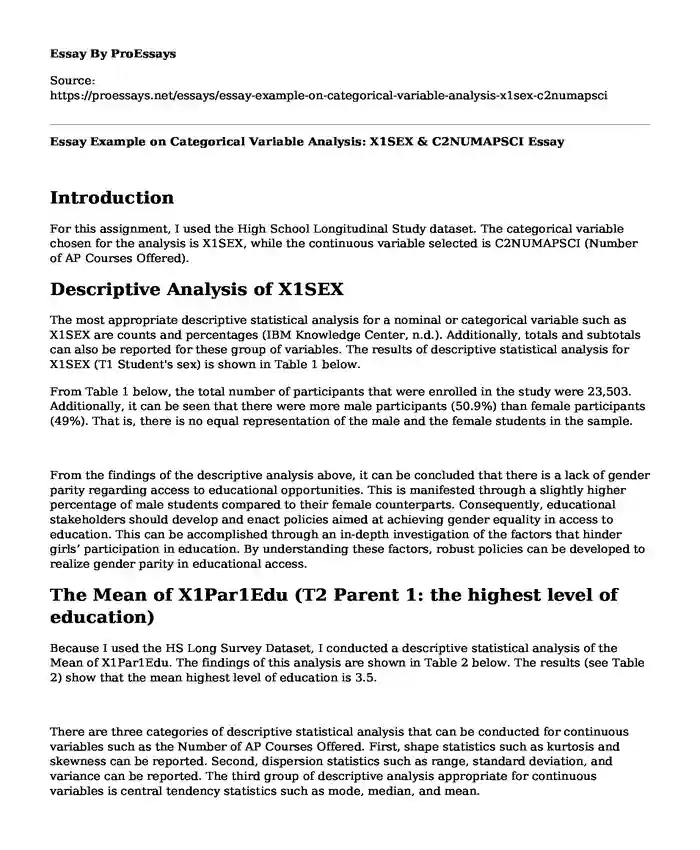Introduction
For this assignment, I used the High School Longitudinal Study dataset. The categorical variable chosen for the analysis is X1SEX, while the continuous variable selected is C2NUMAPSCI (Number of AP Courses Offered).
Descriptive Analysis of X1SEX
The most appropriate descriptive statistical analysis for a nominal or categorical variable such as X1SEX are counts and percentages (IBM Knowledge Center, n.d.). Additionally, totals and subtotals can also be reported for these group of variables. The results of descriptive statistical analysis for X1SEX (T1 Student's sex) is shown in Table 1 below.
From Table 1 below, the total number of participants that were enrolled in the study were 23,503. Additionally, it can be seen that there were more male participants (50.9%) than female participants (49%). That is, there is no equal representation of the male and the female students in the sample.
From the findings of the descriptive analysis above, it can be concluded that there is a lack of gender parity regarding access to educational opportunities. This is manifested through a slightly higher percentage of male students compared to their female counterparts. Consequently, educational stakeholders should develop and enact policies aimed at achieving gender equality in access to education. This can be accomplished through an in-depth investigation of the factors that hinder girls’ participation in education. By understanding these factors, robust policies can be developed to realize gender parity in educational access.
The Mean of X1Par1Edu (T2 Parent 1: the highest level of education)
Because I used the HS Long Survey Dataset, I conducted a descriptive statistical analysis of the Mean of X1Par1Edu. The findings of this analysis are shown in Table 2 below. The results (see Table 2) show that the mean highest level of education is 3.5.
There are three categories of descriptive statistical analysis that can be conducted for continuous variables such as the Number of AP Courses Offered. First, shape statistics such as kurtosis and skewness can be reported. Second, dispersion statistics such as range, standard deviation, and variance can be reported. The third group of descriptive analysis appropriate for continuous variables is central tendency statistics such as mode, median, and mean.
In the current descriptive statistical analysis for C2NUMAPSCI (the Number of AP Courses Offered), central tendency statistical analysis was conducted. The findings (see Table 3) show that the mean number of AP courses offered is 10.86; the median is 10 while the mode is 6. This implies that the distribution of data is skewed to the right.
Social Change Implications
From the findings of descriptive statistical analysis shown in Table 3 above, it can be seen that there are only 11 AP courses offered. This implies that the students are not exposed to all the AP courses that are currently existing in the field. Consequently, educational stakeholders should make efforts aimed at providing students with more AP courses options.
References
IBM knowledge center. (n.d.). Summary statistics for categorical variables. Retrieved from https://www.ibm.com/support/knowledgecenter/SSLVMB_24.0.0/spss/tables/table_builder_cat_sumstats.html
Cite this page
Essay Example on Categorical Variable Analysis: X1SEX & C2NUMAPSCI. (2023, Sep 08). Retrieved from https://proessays.net/essays/essay-example-on-categorical-variable-analysis-x1sex-c2numapsci
If you are the original author of this essay and no longer wish to have it published on the ProEssays website, please click below to request its removal:
- Written Assignment on Math
- Why High Schools Should Look To Implement A Smartphone Ban? - Essay Sample
- Robots, Smart Materials, and their Future Impact on Humans Essay
- Mobile Phone Technology - Essay Sample
- Essay Example on Technological Progress: Transforming Lives Through Innovation
- Essay on Social Media Influencers: An Innovative Solution to Intangibility in Tourism Industry
- Paper Example on Mobile Tech: Revolutionizing Communication in Science







